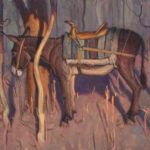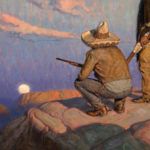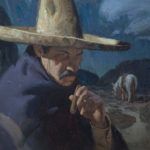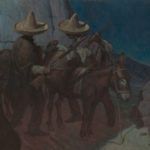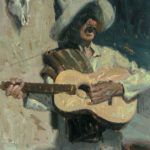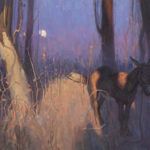Los Angeles, CA
Maxwell Alexander Gallery, August 19-September 16
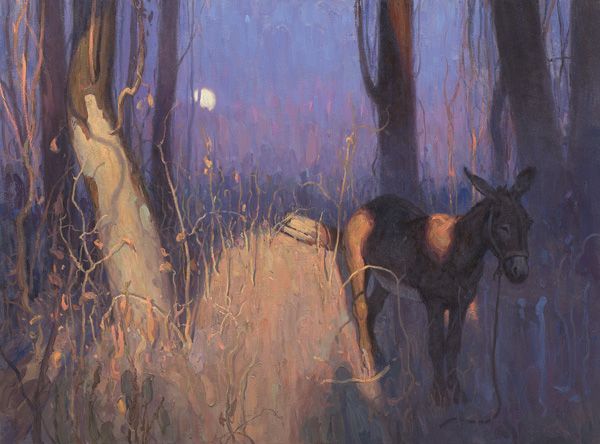
Eric Bowman, The Lost Burro, oil, 30 x 40.
This story was featured in the August 2017 issue of Southwest Art magazine. Get the Southwest Art August 2017 print issue or digital download now–then subscribe to Southwest Art and never miss another story.
For artist Eric Bowman, The End of the Trail is more than just the title of his new solo show. While several of his paintings depict cowboys riding horses on a trail, there’s more to it than that. Bowman lives near the end of the cross-country Oregon Trail, and he is inspired by the famous sculpture END OF THE TRAIL by James Earle Fraser, depicting a Native American slumped over a horse coming to an abrupt stop. “It’s a well-known western saying, has historical significance, and pairs well with all the subjects I’ve painted,” Bowman says. The End of the Trail opens at Maxwell Alexander Gallery with an artist’s reception on Saturday, August 19, from 6:30 to 8:30 p.m. and runs through September 16.
Gallery director Beau Alexander is exhibiting Bowman’s work to bring a new perspective to the western genre. “The addition of the figurative narrative adds a whole new dimension to his work,” Alexander says. “We are now able to place ourselves in the painting and create our own stories.” Bowman’s works tend to position the figures, which are mainly Mexican cowboys or caballeros, so that they are looking at the viewer, which creates a specific emotional experience when looking at the painting. “It’s almost as if we are in that scene, needing to figure out our next move,” Alexander says.
- Eric Bowman, Jack in the Thicket, oil, 24 x 30.
- Eric Bowman, The Watchers, oil, 24 x 32.
- Eric Bowman, They Will Pay, oil, 16 x 16.
Bowman, who is bringing 13 new works to display, says that growing up in Southern California helped ignite his appetite for the Mexican culture. “Mexican cowboys and banditos are fun to paint because they’re not your average cowboys,” Bowman says. “They have bigger hats, more colorful clothing, and they’re more exotic.” Bowman gets inspiration for these idealized, romantic western figurative works from movies and other images from the 1930s and ’40s, sometimes cobbling multiple images together to create a single work. He begins each piece with a sketch to arrange the composition before transferring the idea to a canvas. He then builds up textures with layers of paint, sometimes juggling multiple works in order to let layers of paint dry before continuing on.
But it’s not just Bowman’s paintings that hook collectors on his work. “Many people are drawn to his style of poking fun with his titles,” Alexander says. THEY WILL PAY exemplifies this idea. Although Bowman tries to stay politically neutral, some could see this work as referencing the current political issues between the United States and Mexico. “What the bandito is really saying is that he’s seeking revenge,” Bowman says.
THEY WILL PAY also typifies a term Bowman coined: “mock-turn,” which is a play on the word “nocturne.” Instead of painting these nighttime images in the dark, Bowman plays tricks with daytime sunlight to cast shadows that mimic nighttime shadows and works with blues and grays to minimize contrast in the painting while still adding color to the work. “Even though I’m painting these during daylight hours, I have to keep in mind the sunlight reference I’m using and subdue it,” Bowman says. “Mock-turns add some mystery and attitude to the show. I like having moody paintings mixed in.” —Katie Askew
contact information
310.839.9242
www.maxwellalexandergallery.com
- Eric Bowman, Smugglers, oil, 30 x 40.
- Eric Bowman, Spanish Minstrel, oil, 16 x 12.
- Eric Bowman, The Lost Burro, oil, 30 x 40.
This story was featured in the August 2017 issue of Southwest Art magazine. Get the Southwest Art August 2017 print issue or digital download now–then subscribe to Southwest Art and never miss another story.
MORE RESOURCES FOR ART COLLECTORS & ENTHUSIASTS
• Subscribe to Southwest Art magazine
• Learn how to paint & how to draw with downloads, books, videos & more from North Light Shop
• Sign up for your Southwest Art email newsletter & download a FREE ebook






